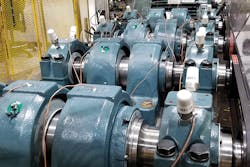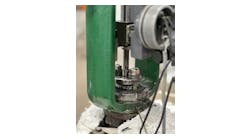Mounted bearings are critical in many applications across a broad range of processing industries, including mining, aggregate, cement and food and beverage. Mounted bearings are used on bulk material handling conveyors moving aggregate, cement, sand, gravel or grain through the production process. You’ll also find bearings in a food or beverage plant, moving product or bottles. Another common application is air handling, with bearings mounted on industrial fans. Mounted bearings are easy to install and their housings offer more protection, which helps in these type applications.
Keeping a check on bearing performance is critical. Failed bearings can lead to costly downtime, not only from lost production but also from secondary damage. Additionally, bearings are often located in hard-to-access or remote locations that make regular inspections difficult and time-consuming and also pose safety issues for workers. Smart sensors can help address some of the performance issues and safety challenges associated with mounted bearings.
Common challenges
While there are many types of bearings, smart sensors are used on standard cast iron and washdown ball bearings and spherical roller bearings — all in pillow block housing styles. They can also be used on tapered roller bearings.
As mentioned, routine maintenance introduces safety hazards as workers are working around rotating equipment or trying to reach bearings that are difficult or dangerous to access. With traditional maintenance methods, the user has little visibility of when component failure may occur. The ability to monitor bearings remotely with smart sensors allows maintenance staff to safely get a health check of the bearing without touching the equipment.
While there are other common challenges, this article focuses on the two critical issues for mounted bearings: vibration and running hot.
ABB Smart Sensor
Addressing challenges
To address some key challenges associated with mounted bearings, ABB carried out an extensive customer survey that indicated customers wanted help when it comes to maintaining and troubleshooting bearing products. One major reason for this is changing demographics. Many highly skilled maintenance mechanics are nearing retirement age. These are experts who can often diagnose bearing issues based on small alterations in sounds or temperatures. Companies are finding it challenging to find replacements with such depth of experience and knowledge in practical mechanics.
The survey also found that many end users didn’t fully understand condition monitoring technology or how to evaluate condition monitoring data. Some companies outsource this task but doing so is expensive. Often the analysis is performed by people who aren’t bearing experts. Some customers surveyed had already adopted a condition monitoring program. However, many others didn’t have the resources or they considered the current cost of analysis too high.
It was clear, however, that most customers saw the benefit in monitoring the health of their key assets and the increased uptime that results. Many customers who were interviewed also believe the internet of things (IoT) will have a significant impact on reducing the barriers that have, so far, prevented condition monitoring solutions from becoming widespread.
Essentially, the survey identified the need for a low-cost, easy-to-use condition monitoring system that would fill most customer requirements.
ABB’s Smart Sensor in an aggregate material handling application in a cement plant
Mounted bearing health check
As a result, a new smart sensor for mounted bearings was developed to let plant operators know when a bearing’s performance is showing signs of trouble. Smart sensor technology assesses the condition of the bearing from temperature and vibration information and provides early indication of potential problems. A bearing running hot, for example, can indicate that proper lubrication procedures are not in place. Vibration issues can indicate potential system problems. Based on information gathered from the sensor, operators can decide when to replace the bearing to avoid catastrophic failure, which can lead to safety and cost benefits. Built-in diagnostic capabilities also reduce the need for condition monitoring analysts. With the information delivered by the sensor, operators can determine how running equipment under different operating conditions influences their machine life. This information helps them know when to order spare parts and how to optimize maintenance and repair schedules.
The smart sensor for mounted bearings is part of the digital powertrain concept, an expanded digital services offering that provides end users integrated monitoring and analytics of other powertrain assets including drives, motors and pumps. Connecting all of these devices can improve the performance, reliability and efficiency of all components within the powertrain.
Installation
Because the smart sensor is wireless, installation costs tend to be lower than with traditional sensor technology. Installed sensors also reduce or eliminate the need for maintenance visits to monitor equipment or to take readings with handheld tools. The smart sensor mounts directly onto a bearing’s housing using simple tools. Newer bearing housings accept the sensor and a retrofit adapter is available for the installed base as well. For example, Dodge mounted bearings come sensor-ready with drilled, threaded and plugged installation holes. The smart sensor is installed by removing the plug and threading the sensor into the provided receptacle. The sensor is activated by pressing an LED activation switch.
The sensor incorporates accelerometers to measure vibrations, and temperature sensors to measure bearing temperature as well as temperature inside the sensor. The sensor housing is sealed to maintain its ATEX certification.
Connectivity
Smart technology like Bluetooth protocol is used to connect the sensor to Android or iOS mobile phones using an app, or through a gateway to connect to the monitoring platform or customer reliability system. This simplifies the process for operators because they can log into one interface to check the condition of their bearings or motors.
A mobile app provides a quick view of condition health and also provides basic information regarding temperature and vibration measurements. If operators want to view more detailed information, it is possible for users to look at trend lines or to extract the data to perform their own analysis.
When bearings are located in difficult-to-reach locations, out of mobile device range, sensor data can be automatically sent via Bluetooth Low Energy to the monitoring platform using a gateway. Twenty of these sensors can be connected to one gateway.
Cybersecurity
The smart sensor for mounted bearings includes complimentary access to the ABB Ability digital platform and has been developed to adhere to strict security measures. In particular, this covers data ownership, as the operator will always own their own data and it cannot be accessed by anyone outside their company unless they have authorization.
The sensor is protected from unwanted access by 16-bit Personal Identification Number (PIN) authentication. This PIN is changeable during commissioning as well as during normal sensor usage, while PIN throttling that limits the number of attempts to guess a PIN prevents brute-force attacks. All the sensor measurements are encrypted according to the recommendation of the National Institute of Standards and Technology (NIST).
Conclusion
Smart sensors for mounted bearings working with other condition monitoring tools can provide insights into asset health conditions that can help operators maximize their process uptime. This forms an integral element of a digital powertrain concept that connects drives, motors, pumps and bearings for enhanced uptime and productivity. Equipped with data insights from the powertrain, operators can become better connected with their assets and make better decisions to ensure safe, reliable and efficient operations.
Artur Rdzanek is a global product manager for ABB, focused on sensor products for Dodge mechanical power transmission products. He has nearly 20 years of product management and manufacturing experience. Rdzanek holds a Bachelor of Science and Master of Science in automatics and robotic engineering from Lodz University, and an executive MBA from Warsaw-Illinois University. He may be contacted at [email protected] or 864-281- 2166.



